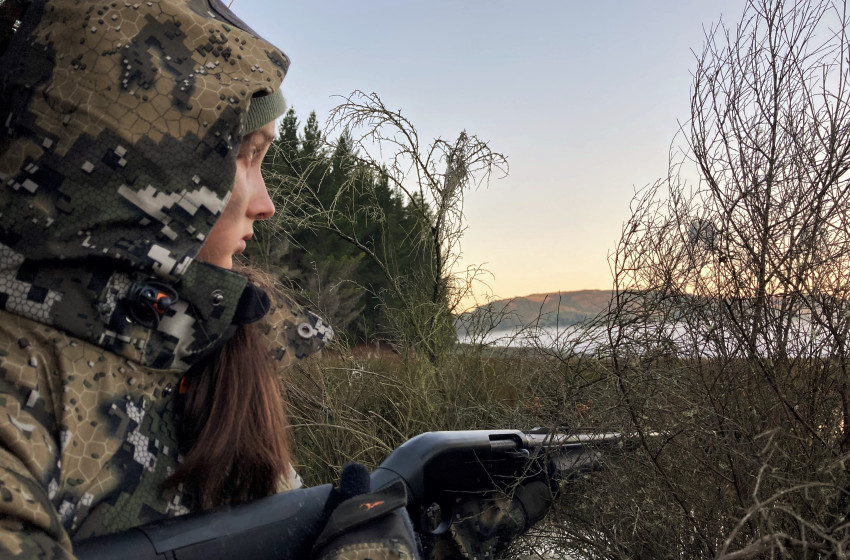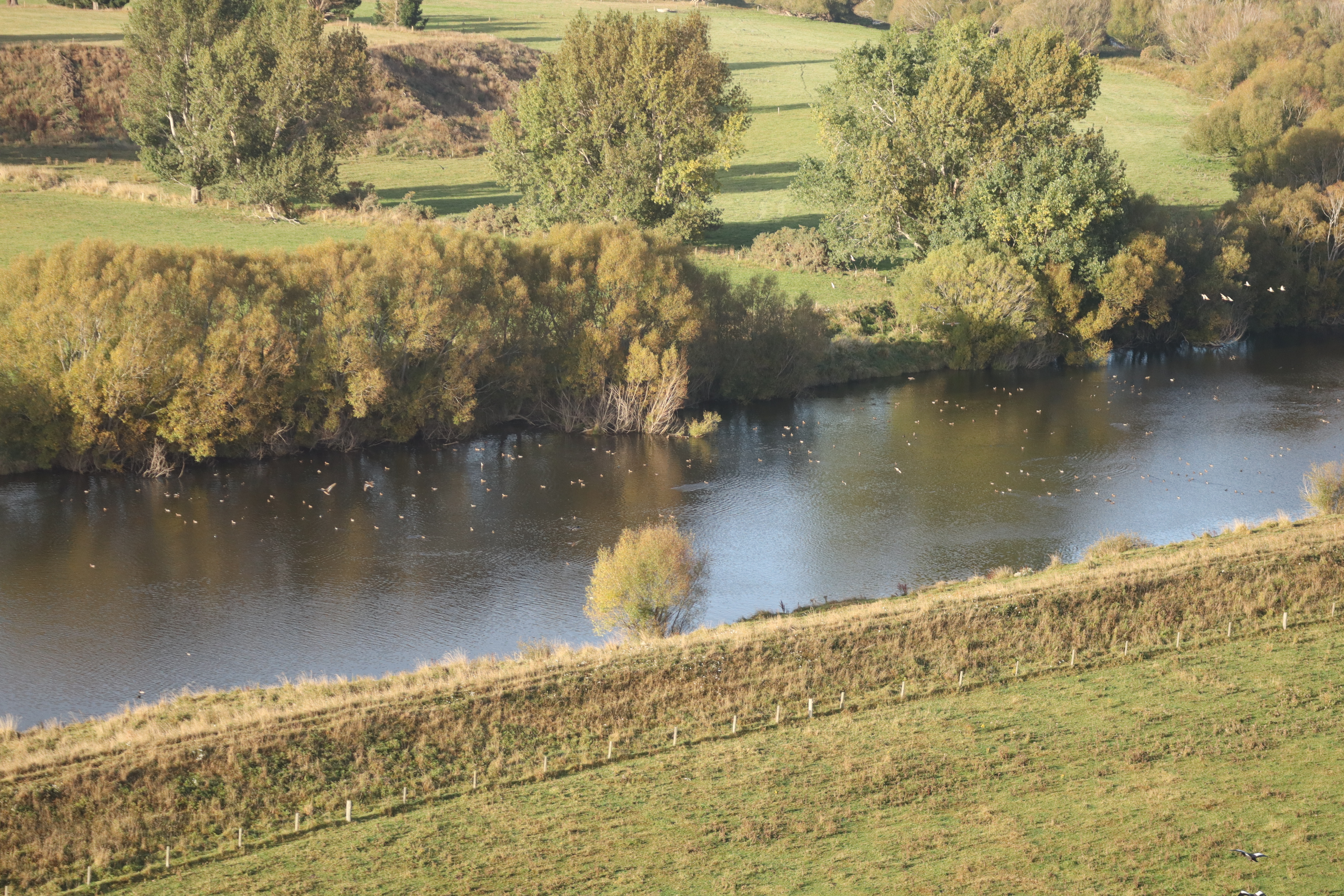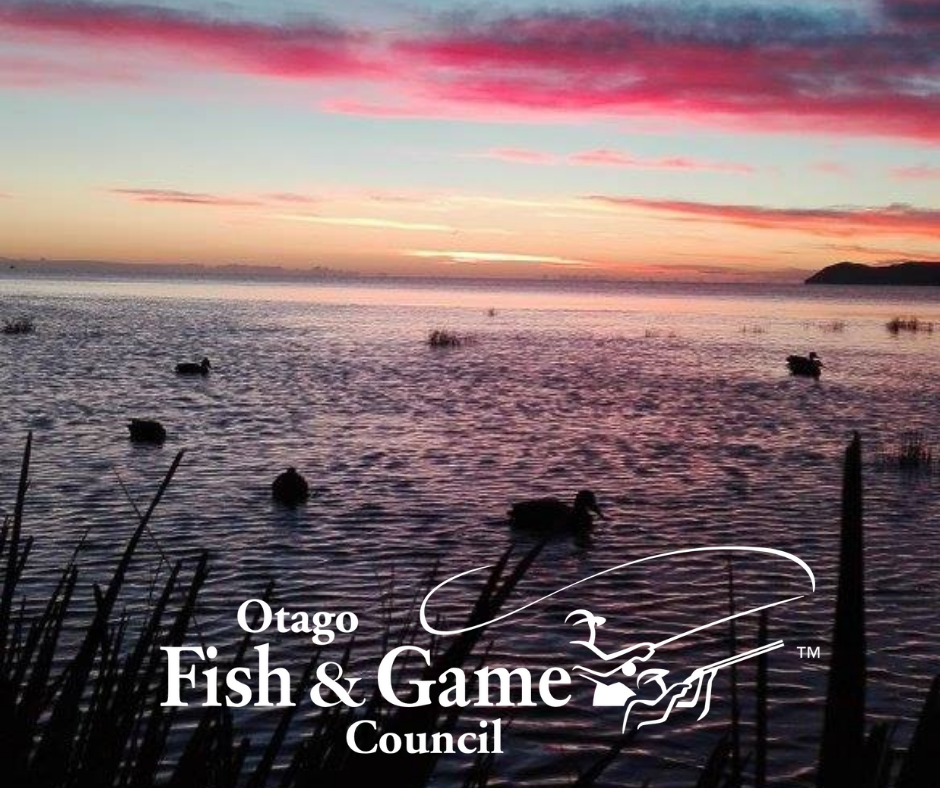Both Barrels April 2022
- Otago
- 14/04/2022

Bring on the 2022 game bird hunting season!
The 2022 game bird season gets off to a bang on Saturday, May 7.
The best experiences in hunting are shared, so take along a friend or family member and make memories.
Good planning will vastly improve your chances for success.
Above Right:Junior hunting at Otago Fish & Game’s Takitakitoa wetland.
Hunters should have tagged their hunting spots and scrubbed maimais by now.
After a good duck-breeding season then months of dry weather, let’s hope for some rain to help disperse the birds and boost the harvest.
Record trend counts

A large raft of mallards is observed on the Taieri River during the 2022 aerial survey.
Thousands of mallards have flocked to Otago rivers only weeks before opening weekend.
Otago Fish & Game recently finished aerial mallard trend counts on selected ponds, river reaches and land transects in coastal areas and South Otago.
The Otago count skyrocketed to more than 10,400 mallards, the highest since aerial monitoring began in 2015. This compared with last year’s trend count of 5600.
Large rafts of mallards were concentrated on the Taieri, Pomahaka and Clutha rivers.
Some ponds also supported high numbers. One pond had more than 900 mallards but several ponds had no ducks or were dry.
While we can’t say definitively there are more ducks in South Otago, the trend is higher than in previous years, for sure.
Variables such as weather and food availability, like grain crops, can all affect the counts.
Aerial monitoring of Otago’s paradise shelduck population in February recorded the highest trend count in 31 years.
So be sure to harvest plenty parries this season, too.
Looking for water? So are the birds!
Lake hunting with portable blinds and a mix of decoy species at the water’s edge.
Otago’s wet spring and early summer equated to full ponds, flooded paddocks, and lots of seeds and bugs ─ excellent conditions for raising ducklings.
This changed by mid-summer when the rain stopped.
Although this won’t harm the duck population, it will affect how we harvest them.
Many smaller ‘traditional’ duck ponds will be low or dry. On the lakes, low levels mean several maimais will be high and dry, far from the water’s edge.
Affected hunters have two options: perform your favourite rain dance, or have a plan B.
Low water levels disadvantage pond hunters but favour the open water hunters.
Ducks still need water to drink, wash and do other activities. As ponds reduce in number, duck populations in remaining ponds will increase.
Good areas for a plan B include lakes, rivers and larger ponds.
On farms, if your pond isn’t holding water, check irrigation dams, creeks or anywhere else there is water.
Or the ducks might be found somewhere without water at all. They often loaf in paddocks during the day, especially if there is irrigation nearby.
Setting up in a paddock can involve full body decoys and layout blinds. Or it can be a simple case of hiding in a broom bush, placing floating decoys in the paddock. If using floating decoys on land, dig the keel into the soil or make a stand from no.8 wire to support the decoys.
When the lakes are low, portable blinds come into their own. Layout, A-frame and haybale blinds can be used, but vegetation is another effective camouflage.
Rushes, scrub, willow trees and driftwood can conceal one or two hunters with decoys set within effective shotgun range.
Riverbeds are often overlooked by waterfowlers. Mallards, paradise shelduck and Canada geese use riverbeds for collecting grit as well as safe loafing areas.
Locating these ‘camps’ beforehand is the way to success.
Once an area is identified, mark it on the GPS, and return before sunrise the next day.
Set your decoys exactly where the birds were seen the day before.
Placing them 100m upstream, or on the other side of the river, will result in birds landing out of range, and a frustrating hunt.
Use layout blinds or natural concealment such as driftwood.
So, if the pond is dry, it doesn’t mean Opening Day will be ruined!
Duck hunting, like every form of hunting and fishing, favours the adaptable.
Make a plan B, even a plan C, and maybe that rain dance won’t be necessary.
Duck Decoy Demo

Learn how to set decoys to help your harvest this season.
Setting the right decoy spread can make the difference between going home with a feed or going home with frustration.
Lakes, estuaries, riverbeds and large ponds are notoriously difficult to hunt, because the birds have such a huge option of places to land that aren’t necessarily within shotgun range.
Otago Fish & Game will run a decoy setting demonstration in Cromwell on Sunday, May 1, the weekend before Opening Day.
The demonstration will include how to set decoys in relation to wind and river currents, how to incorporate different species in your spread, movement, motion, electronic decoys and more.
Fish & Game staff will be able to answer many of your other questions on the day, and provide information on regulations, hunting locations and anything else feather related.
Where: Old Cromwell boat ramp, Butcher Drive, Cromwell
When: 3 pm, Sunday, May 1, 2022
For more information, contact Ben Sowry 027 344 9920
bsowry@fishandgame.org.nz
Or register here:
What’s the go with Bendigo?

Bendigo Reserve area in 1989 (left), and present, showing the influx of willow trees covering waterfowl and upland game habitat
Bendigo Wildlife reserve is a 158ha conservation area at the confluence of the Clutha River/Mata-au and Lake Dunstan.
Bendigo Wildlife Reserve is managed by Fish & Game Otago.
The Department of Conservation (DOC) have deemed the management goals of the area to be (in priority order):
- To manage the habitat and public use so as to enhance waterfowl populations.
- To provide and maximize opportunities for recreational waterfowl hunting.
- To manage the habitat and public use so as to enhance values for protected wildlife.
Under all these priority areas, one of the main issues identified by Otago Fish & Game staff is the encroachment of willows (Salix) on the island and channel areas.
This has resulted in a significant decline in open water areas that waterfowl use as loafing and feeding areas.
It is planned for large areas of willows to be controlled and replaced with less invasive species such as kowhai, manuka, toetoe, flax and Carex secta.
This will open the channels, ponds and backwaters, creating more productive areas for waterfowl to live, breed and raise young.
Otago Fish & Game would like to talk to current users of Bendigo reserve, to see how we can manage this hunting area without affecting existing activity.
If you have a tagged hunting site within the Bendigo Wildlife Reserve boundary, please email Fish & Game officer Ben Sowry bsowry@fishandgame.org.nz
Warm Barrels
Bruce Quirey & Ben Sowry, Otago Fish & Game Officers.